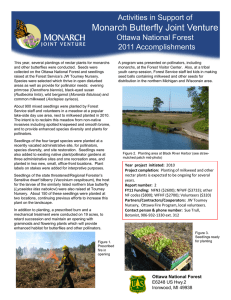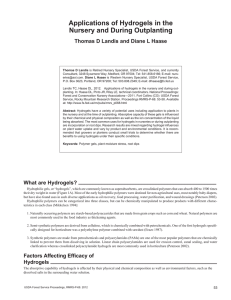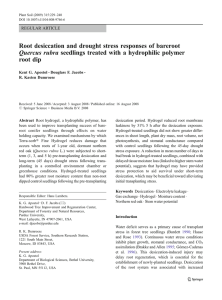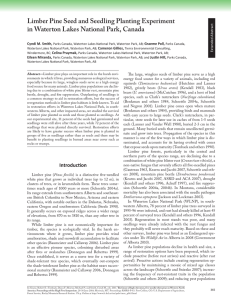Restoration Planting Options for Limber Pines in the Southern Rocky Mountains
advertisement
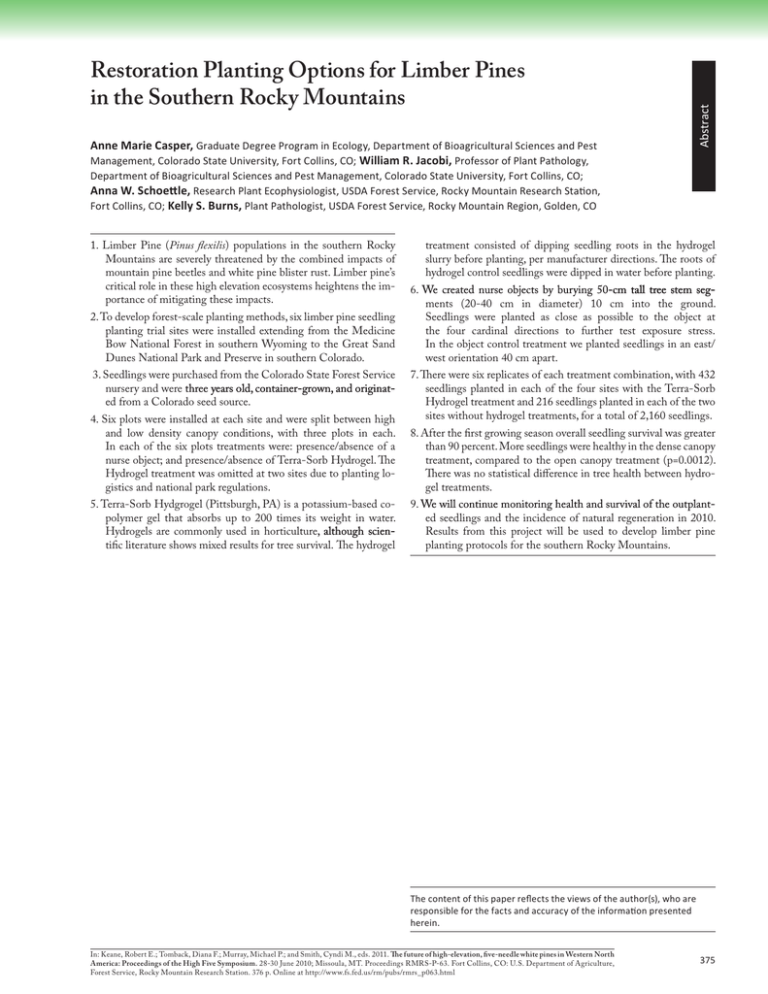
Anne Marie Casper, Graduate Degree Program in Ecology, Department of Bioagricultural Sciences and Pest Management, Colorado State University, Fort Collins, CO; William R. Jacobi, Professor of Plant Pathology, Abstract Restoration Planting Options for Limber Pines in the Southern Rocky Mountains Department of Bioagricultural Sciences and Pest Management, Colorado State University, Fort Collins, CO; Anna W. Schoettle, Research Plant Ecophysiologist, USDA Forest Service, Rocky Mountain Research Station, Fort Collins, CO; Kelly S. Burns, Plant Pathologist, USDA Forest Service, Rocky Mountain Region, Golden, CO 1. Limber Pine (Pinus flexilis) populations in the southern Rocky Mountains are severely threatened by the combined impacts of mountain pine beetles and white pine blister rust. Limber pine’s critical role in these high elevation ecosystems heightens the importance of mitigating these impacts. treatment consisted of dipping seedling roots in the hydrogel slurry before planting, per manufacturer directions. The roots of hydrogel control seedlings were dipped in water before planting. 2. To develop forest-scale planting methods, six limber pine seedling planting trial sites were installed extending from the Medicine Bow National Forest in southern Wyoming to the Great Sand Dunes National Park and Preserve in southern Colorado. 6. ������������������������������������������������������������� We created nurse objects by burying 50����������������������� -���������������������� cm tall tree stem segments (20-40 cm in diameter) 10 cm into the ground. Seedlings were planted as close as possible to the object at the four cardinal directions to further test exposure stress. In the object control treatment we planted seedlings in an east/ west orientation 40 cm apart. 4. Six plots were installed at each site and were split between high and low density canopy conditions, with three plots in each. In each of the six plots treatments were: presence/absence of a nurse object; and presence/absence of Terra-Sorb Hydrogel. The Hydrogel treatment was omitted at two sites due to planting logistics and national park regulations. 8. After the first growing season overall seedling survival was greater than 90 percent. More seedlings were healthy in the dense canopy treatment, compared to the open canopy treatment (p=0.0012). There was no statistical difference in tree health between hydrogel treatments. 3. Seedlings were purchased from the Colorado State Forest Service nursery and were three������������������������������������������ ����������������������������������������������� years old, container-grown, and originated from a Colorado seed source. 5. Terra-Sorb Hydgrogel (Pittsburgh, PA) is a potassium-based copolymer gel that absorbs up to 200 times its weight in water. Hydrogels are commonly used in horticulture����������������� ,���������������� although scientific literature shows mixed results for tree survival. The hydrogel 7. There were six replicates of each treatment combination, with 432 seedlings planted in each of the four sites with the Terra-Sorb Hydrogel treatment and 216 seedlings planted in each of the two sites without hydrogel treatments, for a total of 2,160 seedlings. 9. We ���������������������������������������������������������������� will continue monitoring health and survival of the outplanted seedlings and the incidence of natural regeneration in 2010. Results from this project will be used to develop limber pine planting protocols for the southern Rocky Mountains. The content of this paper reflects the views of the author(s), who are responsible for the facts and accuracy of the information presented herein. In: Keane, Robert E.; Tomback, Diana F.; Murray, Michael P.; and Smith, Cyndi M., eds. 2011. The future of high-elevation, five-needle white pines in Western North USDA Forest Service Proceedings RMRS-P-63. America: Proceedings of the High Five Symposium. 28-30 2011. June 2010; Missoula, MT. Proceedings RMRS-P-63. Fort Collins, CO: U.S. Department of Agriculture, Forest Service, Rocky Mountain Research Station. 376 p. Online at http://www.fs.fed.us/rm/pubs/rmrs_p063.html 375

